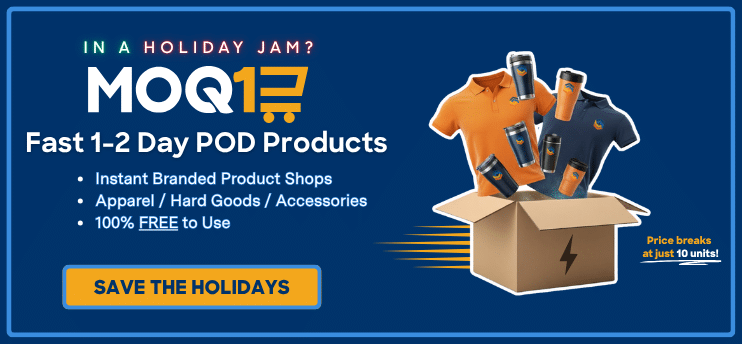Uncertainty makes it almost impossible to plan, and economics experts are warning that the ongoing tariff turmoil will soon make itself felt beyond pricing pressures.
In a speech given May 15, just three days after a short-term tariff deal with China was announced, Federal Reserve Chair Jerome Powell said, “We may be entering a period of more frequent, and potentially more persistent, supply shocks.”
The Wall Street Journal reported a week earlier that “U.S. importers have frozen or canceled billions of dollars worth of orders, potentially leaving them short-handed for the essential back-to-school or holiday sales periods,” adding that some had already paid hefty deposits for products that could no longer be sold for a profit.
‘The World Is Reorienting’
Promo is not immune to these slowdowns. During PPAI’s May 8 webinar on tariffs and trade, Jonathan Isaacson, executive chair of Gemline, the No. 13 PPAI 100 supplier, warned that major U.S. retailers have paused large orders from China, creating “a giant backup” and prompting shipping companies to adjust by rerouting or reducing traffic.
“Where you have a bunch of stuff that’s normally going from China to the U.S., the shipping companies are making the rational decision and they’re reallocating those ships to other routes or … stopping them,” he added. “And once you pull it out, it’s not like you can flip a switch and put it back in.”
WATCH: PPAI Hosts Industry Leaders For Tariffs & Trade Webinar
Isaacson described a similar downshift in Chinese factories – many have furloughed workers due to reduced demand – and noted that “the world is reorienting” as these manufacturers look beyond the U.S. for buyers and business partners.
“There’s a world beyond these bilateral relationships between the U.S. and China that is also happening that has an impact on what happens with us,” he said. “If things magically open tomorrow … [all the major retailers] are going to want to ship, and everything’s going to have to get moving again.”

Jonathan Isaacson
Executive Chair of Gemline
Scrambling To Ship New Stock
All these quick changes have complicated an already complex global logistics system. Container bookings from China to the U.S. were down by as much as 60% in April by some estimates. But with the 90-day reprieve that lowered tariffs on Chinese imports from 145% to 30% starting May 14, many American importers are scrambling to bring in their merchandise before the tariffs rise again. However, the capacity of factories, cargo ships and ports is limited, and that scarcity could add higher shipping costs on top of the 30% tariffs.
RELATED: From Capitol Hill To Crisis: A Firsthand Look At Tariffs’ Impact On Small Business
Jason Miller, a professor of supply chain management at Michigan State University, said in a May 14 LinkedIn post that “90 days isn’t much time. Factories in China that have furloughed workers need to bring them back, raw material orders that were canceled need [to be] reinstated (and time needed to get those inputs to the export factories), and so on. As we learned with COVID-19 lockdowns, supply chains geared towards efficiency aren’t well-equipped for start/stop dynamics.”
In the same post, Miller predicted that “maybe 70%-80% of the paused orders are reinstated.”
How Suppliers Are Adjusting
Ben Zhang, founder & CEO of Washington-based supplier Greater Pacific Industries, PPAI 100’s No. 68 supplier, told PPAI Media just days before the temporary deal was announced that the company was shipping only 24 of about 90 orders that were ready due to tariffs, at that time still as high as 145%.
“It affected us a lot because importing is our core business for the last 31 years,” Zhang said. “When the 145% reciprocal tariff was imposed, our business basically was in pause.”

Ben Zhang
Founder & CEO of Greater Pacific Industries
After the tariff rate was reduced to 30% a few days later, Zhang reported that Greater Pacific saw a spike in inquiries. “Each day we receive nearly a hundred new opportunities,” he said. “However, the closing ratio remains low because the 301 tariff still exists … [and] importing from China is still expensive.”
- In an April 2 executive order, President Donald Trump declared a 10% tariff on all imports into the U.S., with higher tariffs for roughly 60 countries that levy higher rates on the U.S.
- On April 9, Trump announced via social media a 90-day pause on reciprocal tariffs for countries that hadn’t retaliated against the U.S., which reduced tariff rates to 10% on most imports from most countries. However, tariffs on China were raised significantly.
- Trump has signaled that 10% will remain the minimum duty across the board.
PCNA, PPAI 100’s No. 5 supplier, stocked up ahead of the tariffs to build deep inventory. “Like many others in the industry, we are now replenishing those inventories with goods arriving at higher landed costs due to elevated tariffs,” says Neil Ringel, CEO of the Pennsylvania-based company. “This reflects our embrace of the current reality – taking necessary steps to ensure uninterrupted product availability and maintain the level of service our distributors expect.”
Ringel expects the current 30% rate on Chinese goods to drive costs even higher. “We’re working closely with our factories to mitigate some of the impact, but these tariffs will inevitably affect pricing,” he says. “While we’ve made strong progress through our efforts – including years of diversifying our supply chain and expanding our U.S.-made assortment – broad-based tariffs across foreign trading partners have made some cost increases unavoidable.”

Neil Ringel
CEO of PCNA
Despite these challenges, Brandon Mackay, MAS, president and CEO of SnugZ USA, the No. 6 supplier in the PPAI 100, says he remains “super bullish” on promo. “It’s one of the most exciting marketing tools out there for companies or the recipient.”
SnugZ USA maintains a significant base of American-made products, which is helping the Utah-based supplier weather the economic storm, and the company is looking to further diversify its sourcing. “Right now, a third of our goods are under the dark cloud of tariffs. Like every company out there, we’re actively seeking to find new sources,” Mackay says. “Our goal over the next 12 months is to reduce our exposure to tariffs by 10%.”
Some suppliers are dividing the increased costs, absorbing a portion and passing on the rest. In a May 21 email to customers, California-based Fossa Apparel, PPAI 100’s No. 60 supplier, said it will implement a separate 3%-4% tariff charge for each item starting July 1.
RELATED: 4imprint Braces For Supply Chain Disruption, Higher Product Costs
“We are optimistic that progress will continue but given the uncertainty beyond the current 90-day window, we encourage all customers to take advantage of this period of relative pricing stability. Thank you for your continued partnership and support,” the message read.
The company decided to list the tariff as a separate line item after asking two of its major clients whether they’d rather see the cost baked into the product price or broken out – both preferred the latter. “Even before getting their feedback, our instinct was to list it separately. That’s because the tariff isn’t really a product cost increase – it’s an external factor driven by government policy, and it can change at any time,” says Michelle Chen, Fossa president. “It simply is easier to maintain the product cost and change the increase or decrease as needed.”

Michelle Chen
President of Fossa Apparel
That said, the company is absorbing a significant portion of the tariff to help offset the impact. “Charging just 4% on what’s now a 30% increase shows how much we’re trying to shoulder,” Chen says. “Our goal is to show customers we’re in this together, and that we’re doing everything we can to reduce the effect of these tariffs and keep Fossa competitive in the market.”
Even if tariffs remain at 30% or lower, it’s a new world, and between the increased import duties, manufacturing slowdowns overseas and shifts in shipping traffic, pricing pressures are unlikely to ease anytime soon.
“It’s going to be very hard to put this all back together and untangle the knot,” said Isaacson, a PPAI Hall of Famer, during the webinar. “… This is going to take a little while to work out. There will be product to sell, but your customers already know that prices are going up.”


